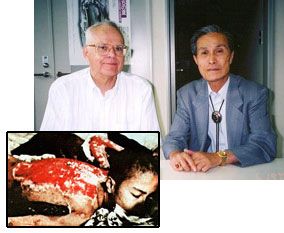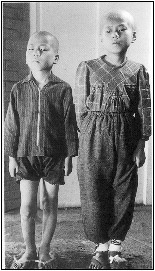 |
Hiroshima
and Nagasaki for College Teachers
A One-week Workshop, June 25 - 29, 2007
Resources
and planning for a general education course or units
dealing
with All Things Nuclear and The Legacy of Hiroshima and Nagasaki
Guide:
Raymond G. Wilson, Ph.D., Emeritus Associate Professor,
Physics
Department, Illinois Wesleyan University, Bloomington, IL 61702
Supported
by The Cities of Hiroshima and Nagasaki*
and friends of the workshop.
|
Illinois Wesleyan University has unusual success with its course, "Problems
of Nuclear Disarmament." It deals with what journalists
have voted to be "The Story of the Century."
Students apparently wish to know about their futures and the challenges
they may have to face.
The instructor (RGW) began teaching about the effects of nuclear war in 1959. He has spent eight summers of study in Hiroshima. In 1979 the “Problems of Nuclear Disarmament” course was created.
Perhaps on your campus there already exists a course which deals with the problems of nuclear war, and the social, biological, and physical effects on the cities and people of Hiroshima and Nagasaki wherein the death toll was well beyond 200,000. We believe such courses are rare. Was one available during your college days? We further believe that college teachers can develop unique understandings and approaches to the problems brought about by contemporary threats to world peace and by nuclear weapons.
In 2002 and 2003 this one-week Workshop was offered solely for physics teachers. It is now available to all college teachers.
You will find below some of the topics of “Problems of Nuclear Disarmament” as taught at Illinois Wesleyan. Would a course something like this fit into the offerings at your institution? If you have interest in developing such a course, or units, about this topic; or if you wish to contribute additional insights and resources to such coursework, we invite you to join us. Here you will find in one place all the resources necessary to provide a good background and stimulus for you and your students in this “Problem of the Century.”
Contact Ray Wilson at rwilson@iwu.edu
if you are interested in participating in this workshop. We will supply
additional information.
 |
 |
Nagasaki:
R. G. Wilson and Sumiteru Taniguchi, June 2001.
Inset:
Taniguchi-san, January 31, 1946, age 16, a "miracle" to survive. |
Epilation
from radiation: Brother and sister of Hiroshima - Did they survive? |
Some
of the Topics of the 3-week May Term "Problems of Nuclear Disarmament".
Illinois Wesleyan University
1999 Headline:
| "Media,
public agree: Atomic bomb story of century" |
Students:
Is this is something you should know about?
"Problems of Nuclear Disarmament” is a May Term (short term) course of 3 weeks duration, for IWU students, meeting 5+ hours per day. Students enroll for only one course during May Term. There are no prerequisites. The course meets a general education requirement, and awards "flag credit" for the requirement of Encountering Global Diversity.
As you can see, in the 3-week course we begin with classic fundamental concepts and work our way through to the modern; but additionally, throughout the course there is a parallel and simultaneous development of: the science and technology of nuclear war; and the social, economic, ethical, human, political and international implications of the nuclear weapons policies of nations.
| Texts: |
Naomi SHOHNO, THE LEGACY OF HIROSHIMA:
ITS PAST, OUR FUTURE, Kosei, 1986 (Tuttle)
James WARF, ALL THINGS NUCLEAR, Figueroa Press, (USC), 2005
Keiji NAKAZAWA, BAREFOOT GEN,
(4 Vols.,Last Gasp of San Francisco), Sel. Readings, and Physics notes
Many other resource books will be available. Physics topics below will be treated appropriately for all. |
3-Week Course Topics to Be Encountered in the One-Week Workshop
Origin of the universe; our nuclear origin.
Origin of nuclei and atoms, the empirical evidence. “Powers of Ten”
The four forces of nature and the energies associated with them.
Bohr theory of the hydrogen atom, energy from atoms. Spectral analysis demo.
Radioactivity. Demo's: Cl-36, lantern mantle, clock dial, trinitite, etc.
Appropriate nuclear physics and nuclear energy.
Biological effects of ionizing radiation, radiation doses. “Half Life,” “Radio Bikini”
Making a fission-fusion-fission bomb.
Nuclear testing: Effects on the Japanese, Pacific islanders, U.S. downwinders, and at Semipalatinsk.
Effects of an all-out nuclear attack on London; protecting one's self. Nuclear War: “A Guide to Armageddon”
Topics Related to Public
Policy and the Applications of Science and Technology
The world at war, ~1939-1945. BBC "World at War: Japan 1941
- 1945," "Hiroshima," "The Day After Trinity"
The Hiroshima/Nagasaki experience. Ibuse's "Black Rain,"
"Prophecy," "Barefoot Gen," "A Mother's Prayer"
Japanese and U.S. political conditions during the last months, weeks,
of WWII.
Physical, biological, social ramifications for hibakusha;
Japanese government response and responsibility.
The arms race, 50 years & 127,500 nuclear warheads; billions
of $,
creation of 70 Hiroshima bombs every day
for 50 years. Demo: 6000 BBs into metal wastebasket (Dot chart)
World Military and Social Expenditures. (Ruth Leger Sivard)
In Defense of Nuclear Weapons.
Oppenheimer's Conjecture on World Peace.
Understanding the many aspects and implications of a war of mass destruction: Should U.S. policy continue to expend massive resources on new military preparedness and defense, or is there some way those same resources could be used to eliminate the need for weapons of mass destruction? If life in the U.S. and in the Developed World is good now, how much better could it be throughout the world if there were no threats of war or mass annihilation for all nations? What shall be “the story” of the 21st century, nuclear war, or peace, or . . .?
The linkage of the topics above to “public policy” is best illustrated by considering the questions and tasks which can arise in the 3-week course. The questions and tasks are handled in a variety of ways: in class and out of class, individual expressions or group consensus, detailed investigations of specific nuclear catastrophes, and short papers.
During the first minutes of the course, students are confronted with the question of use of atomic bombs on Hiroshima and Nagasaki, are asked to consider the Christian perspective on this question and what this means in terms of national policy. This question can arise several more times as students come to a full understanding of the reality of nuclear war.
The three week nature of our course limits extensive research into nuclear and nuclear policy problems. This places considerable responsibility upon the instructor to provide appropriate course material and have it all readily accessible, and still leave an open door for students who wish to tackle a problem of personal importance to them.
Most, if not all students, will have an incomplete understanding of nuclear effects, nuclear policies, and what happened in our first nuclear attacks upon Hiroshima and Nagasaki. The instructor attempts to provide a base of understanding, but the social, ethical, and political issues continue to remain very much open to debate. Our intention is not to reach any consensus, but to inform, and indeed inform of the viewpoints and new concepts of “world policies” that will affect students' lives over the next century.
A course “Reference bibliography” is available.
Following, are some typical
problems, issues, and ideas with which students can "wrestle." It will
be noted that some relate to past events which may continue to influence
current and new policies.
1. Have there been any world conflicts in the years following WWII that would justify use of nuclear weapons? If nuclear weapons “save lives and end wars sooner” should they have also been used in Korea and Vietnam. Why were they not?
2. From your understanding of nuclear explosion effects, estimate the nuclear radiation dose received by 2-year-old Sadako Sasaki, on Aug. 6, 1945, in her home near the Misasa Bridge in Hiroshima, and try to determine if that radiation could have been sufficient cause for her leukemia and death at age 12. Are there limits to knowledge of physical cause and effect? Compare her dose with the federally recommended standards for safe exposure. Is there a low limit of nuclear radiation dose to humans, below which no harm will occur? Should there be special limits for children? (Effect of DU on Iraqi children.)
3. At the course mid-point: Write to parent(s) or significant other describing how your new understandings of nuclear war and policies have affected you. How have you changed? Compare what you understand now with your knowledge at the beginning of this course. What international nuclear policies are acceptable to you?
4. Should the United States attempt the construction of a barrier to nuclear attack? Would such be possible? Would it be affordable? Is the creation of a “fortress America” a proper approach to this international problem? Who is to be saved?
5. Was it proper and justifiable military policy for the Allies to use nuclear weapons, i.e., commence nuclear war, against Japan in 1945? Your reasons? How would a citizen of Hiroshima or Nagasaki respond to this question? Were there alternatives which would have been likely to achieve an end to WWII but without as many deaths? Were nuclear weapons or invasion the only possibilities? On the Internet is the question, “Was President Truman a war criminal?”
6. Should the pictures of Hiroshima and Nagasaki victims have been “classified” and kept from public view for some
22 - 30 years after WWII? Why do you believe this was done? In this world of modern communications could such information in a new situation still be withheld? Have you seen the effects on people from recent wars in Africa, Afghanistan, and Iraq? Are depleted uranium (DU) warheads really as dangerous as some believe them to be?
7. Discuss, critically comment, on the ideas in Leeper's short paper, “In Defense of Nuclear Weapons.”
8. Discuss, critically comment on Wilson's paper, “Peace: A New Way of Thinking about Achieving and Preserving It.” Could this lead to a “Manhattan Project for World Peace?” Can you conceive of a program of shifts in international relations that could likely assure: peace, justice, prosperity, and fairness for all nations? Of what would such a program consist? What protection and assurances would you require?
Some possible AV material:
| BBC World at War: Japan 1941-1945 |
Barefoot Gen (from Japan) |
| A-Bomb Survivors Recollect(Japan) |
Pika-Don (Japanese) |
| Prophecy (from Japan) |
Sadako and the Thousand Paper Cranes |
| The Day After Trinity |
Hiroshima (Spottiswoode/Kurahara, Canadian/Japanese 1995) |
| Black Rain, (Ibuse's from Japan) |
Nuclear War: A Guide to Armageddon (BBC) |
| Hiroshima: A Mother's Prayer |
Goodbye War (from Gwynne Dyer's "War" Series, Canada) |
| Radio Bikini |
Half Life: A Parable for the Nuclear Age (Australia) |
| Starting Your Life in Japan |
The Way of Life in Japan |
| Twenty-Four Eyes (Japanese) |
MacArthur's Children (Japanese) |
| The Colonel Comes to Japan |
Come See the Paradise |
| Paul Jacobs and the Nuclear Gang |
Price for Peace From Pearl Harbor to Nagasaki |
|
|
| *http://www.mayorsforpeace.org/english/hnpc/hnpc_top.html |
|


